Amazingly flaky, light and tender gluten free pie crust recipe isn’t difficult to make when you use the right ingredients and follow some easy how-to steps with this recipe. In fact, this is THE BEST GLUTEN FREE PIE CRUST RECIPE because it’s the simplest gluten free pie crust recipe and it turns out so well every time.
Only 5 ingredients, one bowl and the confidence to believe in grandma (I mean, grandma is always right), you can’t go wrong with this recipe!
Light and flaky gluten free pie crusts are possible with gfJules Flour!
What’s The Secret to the Best Gluten Free Pie Crust?
I’ll let you in on a little secret: lots of other gluten free pie crust recipes tell you that you have to press the crust in the pan. That’s because you can’t roll their crusts.
Lots will tell you that you have to add sugar. That’s because they’re covering up for gritty tasting gluten free flours.
Lots will tell you that it’s difficult to make a good gluten free pie crust. That’s because … well, because they haven’t tried the best gluten free pie crust recipe — this gluten free pie crust recipe.

Fair warning: the intro to this recipe is l-o-n-g, NOT because it’s difficult to make a great gluten free pie crust, but because I want to REASSURE you in every possible way (photos & videos) that it’s really quite easy to make the best gluten free pie crust and that YOU can do it!
If you already trust me, then just jump right to the recipe and do exactly as I say. Don’t substitute ingredients and don’t skip any steps. You won’t regret it!

I’ve written out my secrets and tips, I’ve shared my fool-proof gluten free pie crust recipe, I’ve included videos of the steps, I’ve recorded a podcast to walk you through everything you need to know to make a great gluten free pie crust, and I’ve shared step-by-step photos so you can consult this post as you make a pastry for yourself.
Don’t let the length of the post scare you — it’s all here to help!
Just look at this gorgeous, flaky gluten free pie crust. It’s within reach, and YOU can make it, even if you’ve never made a homemade pie crust in your life!

How Do I Make the Best Gluten Free Pie Crust?
I’m here to SHOW you how to make the best gluten-free pie crust with a simple recipe, photos, video and even a podcast! I’ve traveled the country speaking to gluten-free groups and teaching gluten-free cooking classes, and it seems that rolling out pie crusts is the one thing that scares people the most about baking gluten free. There are many techniques I’ve developed over the years, and I’ve gotten it down to quite a science!
One way many folks find it easy to roll out and transfer crusts is by using a pie crust bag.
Check out this video below.
If you haven’t seen one of these handy kitchen accessories, take a look at my video showing how to use them! (You can also find these in my store)
Another favorite of mine is using a silicone or cloth pastry mat and my favorite rolling pin covers. Together, they are so versatile and make it easy to transfer gluten-free pie crusts or to roll out sugar cookies or ravioli or or or … you get the idea!
Here’s a quick video of how to transfer a gluten free pie crust using a rolling pin and a silicone mat.
I also have a video showing how to use these mats and rolling pin covers for rolling out gluten-free pie crusts.
Consult my recipe below and be sure to look at the step-by-step photos at the bottom, where I show how to transfer the crust.
Because doughs made with my gfJules Flour actually have STRETCH to them, it makes it easy (yes, easy!) to transfer pie crust without tears! (Or maybe that was just me who cried over broken, crumbly gluten free pie crusts when I first got started???)
But the most important trick to making a deliciously flaky and remarkably easy-to-roll-out gluten-free pie crust, is to start with the right ingredients.

What Ingredients Make The Best Gluten Free Pie Crust?
gfJules™ All Purpose Gluten Free Flour hands-down makes the best gluten free pie crust. It’s already light and clean and grit-free. The special blend of gluten-free flours and xanthan gum gives doughs extra stretch, making it far easier to roll and transfer top and bottom crusts.
A combination of butter (or non-dairy alternative like Miyoko’s Vegan Butter or lactose free Green Valley Organics® Lactose Free Butter) as well as shortening makes for a flakier crust. Note: I do NOT like using coconut oil in place of shortening. It doesn’t play nicely with the flour and makes for an oily dough that is more brittle and sticky — no fun to work with!

Using cold water and a surprise secret ingredient that no one will ever taste (spoiler alert: secret ingredient is vodka or other distilled grain alcohol) also makes it easier to work with the dough, and yields an amazingly delicious crust that’s flaky and soft every time. (And yes, the secret ingredient is gluten-free, of course!)
This secret ingredient is IMPORTANT. Please use it, as well as shortening + butter, as well as gfJules Flour to achieve the lightest, softest, flakiest gluten-free pie crust. If you cannot use the secret vodka ingredient, use white vinegar in its place for the most tender crusts.
Why Don’t Gluten Free Pie Crusts Brown Like Gluten Crusts Do?
Gluten-free pie crusts don’t brown like wheat crusts because they have less protein in the flour. If you don’t add sugar to the crust or brush the top of the crust with egg wash or something with protein in it, there’s nothing to brown, but don’t let that fool you into thinking your crust isn’t cooked! DO NOT OVERCOOK YOUR PIES.
If you wait for your gluten-free pastry to brown before you take it out of the oven, it will become hard and over-cooked. This is one reason it’s important to brush your crust before baking with either egg wash (one whole egg, mixed, plus 1 tablespoon water or milk) OR milk so that the crust won’t dry out while cooking and will brown more.
The egg wash or milk will be what browns, not the flour crust. You can also sprinkle cinnamon-sugar on your crust for more color, if you like.

FAQs for Gluten-Free Pie Crusts
I find myself answering lots of emails in advance of pie baking season and folks are all worried that they’ll make a tough pastry crust.

In answer, I usually write pretty much the same things, so I’ll copy a note I wrote recently below, as it’s a good recap of the main tips for making the best gluten-free pie crust.
Top Tips for how to get the flakiest gluten-free pie crust:
- For the flakiest gluten free pastries, make sure the butter is super cold when adding it. I like to cut it into pieces and then put it in the freezer while I’m measuring the flour and getting everything ready. Be sure to measure your flour properly for this, and every gluten free recipe. It’s super important!

Gluten Free Apple Pie baked in Emile Henry Pie Plate. - When you add the butter, cut both it and the shortening into the flour/salt mixture with a pastry cutter or two knives cutting against one another, and only cut it as much as you need to integrate the fats into the flour into small balls, without working it too much. Then add the vodka or vinegar or cold water (start with only 3Tbs) and mix with a fork, adding only as much more cold water as you need to get the dough to hold together without being wet. A wet dough is a heavy dough and you don’t want that!

- Then wrap the dough in cling wrap and leave on the counter for 30 minutes if it’s not too warm in the kitchen, or refrigerate for about 10-15 minutes if you think you worked it too much or the kitchen is warm.
-
Roll it out and into the pie pan and then … I’ve found that covering the crust with wrap again in the pan and putting it in the freezer while you work on other things, THEN filling the crust, is a great way to keep those fats nice and cold before baking.
-
The steam that is generated from the fats melting in the oven is what causes most of the flakiness, so if you have lots of little balls of fat throughout the crust, as opposed to melty strands of fat, it creates more flakiness.
-
That being said, overcooking the crust can also make it tough, so brush the crust with egg or milk to help it brown so you aren’t tempted to leave it in the oven too long, waiting for it to brown.

See below for step-by-step photos!
Here are some videos showing the recipe in action
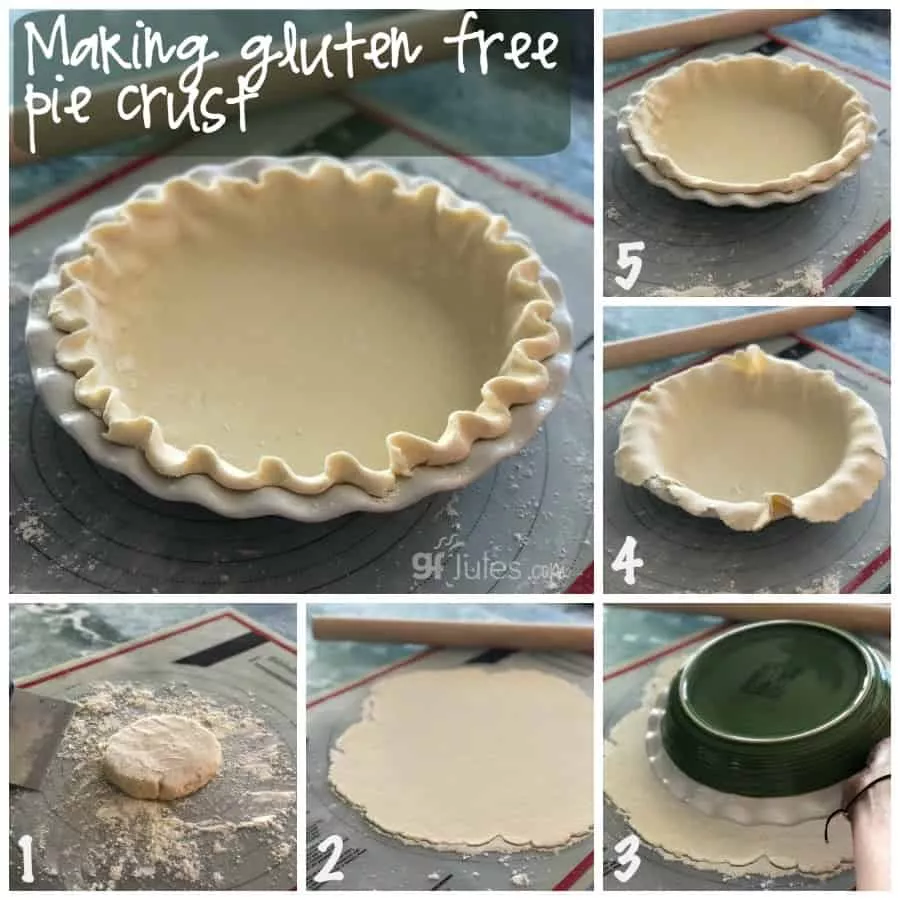
The BEST Gluten Free Pie Crust Recipe

Gluten Free Pie Crust Recipe and Tips
Equipment
Ingredients
1 Gluten Free Pie Crust (double for 2-crust pie)
- 1 (135) cup (grams) gfJules® All-Purpose Gluten Free Flour
- 1/2 teaspoon sea salt
- 2 (1) Tbs (ounce) shortening OR lard OR cream cheese/vegan cream cheese (1 1/8 ounce) (I recommend Spectrum® Organic Palm Shortening*
- 3 (1 ½) Tbs (ounce) COLD butter or non-dairy alternative
- 3 Tbs vodka** (OR white vinegar)
- 1-2 Tbs cold water add more or less to get the dough to hold together but not be sticky
- egg wash (1 egg + 1 Tbs. water) OR milk (dairy or non-dairy) for brushing on crust
Instructions
To Make the Dough:
- In a large bowl, whisk together the dry ingredients.
- Cut in the shortening/cream cheese and cold (not frozen, but very cold) butter using a pastry cutter (or the flat paddle attachment on a stand mixer or a food processor).
- Add the vodka & water gradually to make the consistency you need to form a ball -- err on the side of it being wetter rather than crumbly, but only add the liquid you need to get it to hold together, not too much! Do not over-work the dough, or it may become tough when baked.
- Form a disc with the dough, wrap in plastic and set aside on the counter for 30 minutes or refrigerate while you make your filling.
Rolling the Dough:
- After allowing the dough to rest, roll the pastry out onto a surface dusted well with gfJules All Purpose Gluten Free Flour.
- Use a flexible pastry mat (e.g. Silpat or cloth mat) and rolling pin covers or a pie crust bag for rolling and transferring your gluten free crust easily.
- Gently roll in each direction — do not press down on the pin while rolling — to a circle with a diameter at least 1 inch larger than that of your pie pan.
- Click on the pictures above the recipe card for quick videos on how to easily transfer a gluten free pie crust into the pan.
To Transfer the Crust:
- 1- Gently lift an edge of the rolled out crust over your rolling pin. 2 -With one hand under the baking mat, use the pin in the other hand to lift the crust so that it is supported by the rolling pin as you pull the crust gently off of the baking mat. 3- Transfer gently over the pie plate to center. 4- Drop gently into the plate and allow crust to slump into pan. 5- Pat into your pan. (See photo above recipe card)

- For a One Crust PieCut the edges of the crust to an even length of approximately 1-inch larger than the diameter of your pie plate.
- Gently fold the edges under, then press with a fork or spoon or pinch into a fluted design between your fingers. Cover with plastic wrap and freeze while you make your fillings.

- Fill with your desired filling.
- For a Two-Crust PieDouble the ingredients and divide the doubled pie crust dough before setting aside. Shape each half into a disc and wrap each in plastic wrap. Repeat the rolling out steps for the first crust and cover with plastic wrap, then freeze for 30 minutes or while you prepare the fillings. Fill the pie and lay the second crust gently onto the top of the filled pie pan.
- Cut off all but 1/2 – 1 inch of excess pie crust from around the edge of the pan. For fruit pies, cut small slits in the center of the top crust to allow the hot steam to escape. Brush the crust with egg wash or your milk of choice – this step helps it to brown nicely.

- If there are any tears in your top crust, never fear! Simply take leftover crust and use decorative cookie cutters to cut out leaves, pumpkins, etc. Wet the backside of each cut-out with a dab of milk, then lay on top of any tears to cover the flaw.
- Use pie crust shields to prevent crust edges from over-cooking.
- Fold approximately 1/2 inch of excess pie crust over all around the edge to form the crust, then using your fingers, press a fluted design or use a fork to go around the crust to finish.
- Your pie is now ready to bake or to freeze for later baking. For directions on how to freeze the pie dough and bake later, hop to my post on that method. To bake now, follow the instructions below.
- Single-Crust: Preheat oven to 400º F (static). Brush the crust with egg wash or milk, then cover edges with foil or pie crust shields to minimize burning. Bake for 15 minutes. Reduce heat to 375º F (static) and bake an additional 20 minutes, remove the pie crust shields, and bake an additional 10 minutes, or follow directions for your specific pie recipe.
- Double-Crust Pie: Preheat oven to 400º F (static). Brush the crust with egg wash or milk, then cover edges with foil or pie crust shields and bake for 15 minutes.
- Reduce heat to 375º F (static), remove foil and brush again with egg wash or milk. Bake an additional 35-45 minutes, or until the juices are bubbling, or follow directions for your specific pie recipe. (Cover again with foil if the crust is browning too much during the bake).
- Unfilled Pie Crust (Blind Bake): Cover crust in pie plate loosely with plastic wrap and refrigerate for 30 minutes. Preheat oven to 375º F (static).
- Prick the bottom of pastry all over with tines of a fork. Cover the pastry with parchment paper and pour pie weights, dry rice or dried beans on top to cover 1 inch. Brush the crust edges with egg wash or milk, then cover crust edges with foil or pie crust shields. Bake for 15 minutes or until the bottom of the crust no longer looks raw.

- Remove the parchment paper and weights. Return to bake for 6-8 minutes if filling with quiche, pumpkin or key lime type filling which will be baked further; for cream pies and refrigerated fillings, bake 10-15 minutes more. Don’t wait for the crust to turn brown before removing or it will have over-cooked. Cool completely on a wire rack before filling for refrigerated pies.
Notes
** Please keep in mind that nutrition information provided is per serving, which may vary. While we have taken care to provide you with the most accurate nutritional values possible, please note that this information may differ significantly depending on the exact ingredients and brands that you choose to use to make this recipe. Additionally, where options are given for ingredients, the resulting calculation may include all ingredient options instead of only one per line, skewing the totals significantly.
I hope you love this recipe as much as we do!
Pin it for later!













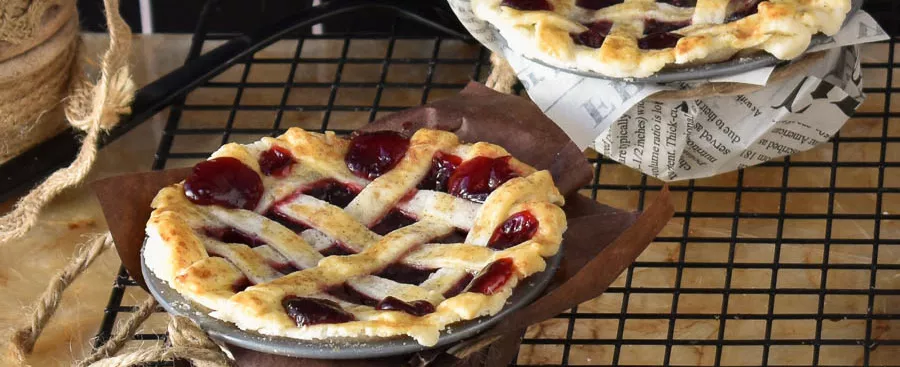
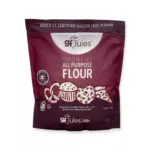


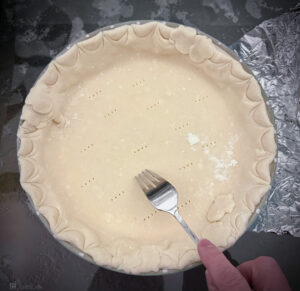






















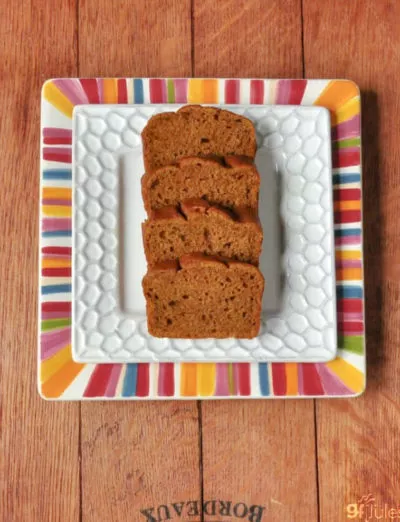









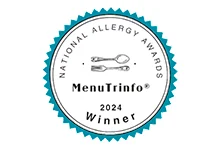
Sadly, we are no longer able to us your flour (hubby is feeling much better now that he is taking his allergy to corn as seriously as those to gluten, soy, nuts, etc.), but we sooo appreciate your recipes! Thank you, thank you for making them free to all! And, yes, to all those who are curious, the vodka really does help, even with a different GF flour. -sylvia.
oh! I forgot a few other tips we’ve discovered: We like to use lard in place of shortening (can’t do soy!), and when we haven’t had that, we’ve used unsalted butter. Finally, for others who aren’t able to use the fabulous GFJules flour, this might be useful to know: we found it easiest to skip the rolling step and just press the dough into the pan, with a lot of flour on the fingers. It makes for a nice “rustic” look. 🙂
Thanks for sharing your tips, Sylvia! I’m glad your hubby is feeling better now that all of his allergies are being considered. I wish happy baking to you all!
~jules
I have an allergy to corn and wheat, also. It is difficult to find good crackers, breads, etc. I found a cracker ” Harvest Stone” with chickpea flour that is delicious. It is at Costco.
I am a first timer, about to make an apple pie, using your all purpose GF Flour.. I just finished making the dough. Can I hold off on making the pie? I want it to be fresh so will put the filling in the crust tomorrow morning.
I did double the recipe and have the discs in plastic wrap. Should I refrigerate it overnight or just leave it on the counter?
Hi Tonja, if you have time, I would roll out the bottom crust and put it in the pan, then freeze it according to these directions. If you don’t have time (and either way, for the top crust) put in the fridge (wrapped well) overnight and then allow to come closer to room temp before rolling so it’s not so hard. Enjoy that pie!
~jules
I saw your video on how to make pie crust and I have ordered the flour and am going to try to make my very own crust. Thanks
I’m so excited for you to have the flour and the recipe ready to go! Please let me know how you like it, and I hope you have a wonderfully happy Thanksgiving!!!
~jules
Can you use Glee in place of the lactose free butter? I just ordered you starter set a few days ago and want to do this crust for pumpkin pie this Thanksgiving. I can’t wait to receive my order.
Hi Alison – I think ghee would be great here! Enjoy that Starter Pack — it’s got some great goodies inside!!! Wishing you a wonderful Thanksgiving!
~jules
I r
Jules I don’t have vodka but do have some clear tequila. Would that work too? Love your gf flour! Thank you! Gluten Free Lady
Honestly Sue, I think it would be fine! I’ve used bourbon instead and it works too — the principles (and the alcohol) work the same. Let me know how it goes!
~jules
Use the vodka in the pie crust recipe, even if it means a trip to the liquor store! I made one without it and while it was fine and tasted great, it was a little difficult to work with. The one I made with vodka was amazing and so much more pliable! And delicious, of course, with absolutely no taste of alcohol. My gluten eating extended family had no idea it was GF because it was tasty and light. Not until they saw my celiac daughter eating it did they realize!
Thanks for sharing your experience with the crust recipe, Mandy. Sometimes subtle ingredients make a huge difference! Congrats on the crust everybody loved!
~jules
So any vodka is ok or does it need to be potato vodka. I have seen different comments as to whether normal vodka processing removes gluten or not.
Hi Cindy, distilled alcohols like vodka ARE gluten free. The only exception would be if a manufacturer went back after distillation and added more grain for flavoring. Many alcohol distillers are starting to even label their products gluten free, but know that distillation means that gluten is not in the final product. Here’s more information: https://gfjules.com/alcohol-gluten-free/
Buying potato vodka is also a great option, but it’s not required. (great question though!!). Hope my article explains it further. Enjoy the recipe!
~jules
That confuses me, because many vodkas are made with wheat?
Hi Lisa, if you take a look at this article on gluten free alcohol, you’ll see all about distillation and the process which removes gluten from the end product, even if it was made with wheat.
I hope that helps explain it, but of course feel free to just use potato vodka if you still have concerns.
~jules
I just found your site, and this recipe, because my husband has developed an intolerance to gluten and he absolutely LOVES pie. My only problem with your recipe is the vodka. I will not have an open bottle of it in my home because my husband is also a 30+ yr recovering alcoholic. My usual pie recipe uses vinegar, would that be a good substitute for the vodka?
Hi Claire, I know you and your hubbie are going to love this recipe. Pie crusts made with my flour are so easy to work with and turn out light and flakey — so good! To replace the vodka, you could use white vinegar if you’re used to using that, or just use more cold water.
Let me know how it turns out for you!
~jules
Absolutely Awesome!!
My mom always makes the most amazing pies. When we were diagnosed with Celiac her flaky pie crusts were something I truly missed. Many attempts at crusts left me with sad rubbery, tough crusts. Our house has gone years without pies! The other day I had apples that needed to be used so I decided to give your recipe a go. I admit I was a bit perplexed seeing vodka in the recipe. But it rolled out easily on parchment paper and tears were easily mended. All I can say is that we had one very have happy family! My husband said “This is the best crust you have ever made!” I look forward to making pot-pies again. 🙂
The best GF crust I’ve ever tried! I have tried a lot of GF pie crust recipes over the last 15+ years and none of them tasted very good or had a good texture. I resorted to buying a pre-made crust which was ok. Now that I’ve tried this recipe, I will use it exclusively! Light and flaky! Thank you!!!
So happy you love it to, Janelle!!! It’s a no-fail crust option that I use all the time for pies and even pot pies! Grandma is always right! 🙂
~jules
Can one use gf beer in place of water?
Hi – yes you can certainly use gluten-free beer in place of water. It will add a different flavor to the pastry, but should be yummy!
~jules
Vodka is usually made from malted grains=not gluten free. Use vodka made from potatoes.
Actually, the distillation process removes the gluten naturally found in whiskey and vodka and the like, as Jules writes about in this article about alcohol, found here: https://gfjules.com/alcohol-gluten-free/
It’s a common mis-perception, but, for the record, distilled spirits are safe for a gluten free diet.
Thanks for your contribution!
There are at least two vodkas that are gluten free.Both made in Texas. One is Deep Eddy Vodka
I like your ideas about baking pies, etc. I would like to order some products from you. Please give me your website. Thanks. ????
http://www.gfjules.com
I would like to make your crust for our pumpkin pie for Thanksgiving tomorrow. I don’t have your gluten free flour mix though. I have Pillsbury Gluten free blend and hoping Pamela’s Gluten Free flour is arriving in the mail today. Could I sub either of those for yours? Thank you!!
Hi Stefanie, I’m not familiar with either of those blends to know whether they would work. I would think that the crust would still taste good, even if it lacked the stretch from my flour that makes it easy to transfer into the pan. If you’re making a one-crust pie like pumpkin, it won’t matter if the crust falls apart because it will be covered by the filling! Use some cookie cutters to cut small decorative shapes to arrange around the outside of pie crust to make it pretty, even if it’s not as easy to flute or make an even edge. If you’re using a top crust too (like apple pie) then I would cut tons of shapes out of the dough and layer them on the top so you don’t have to worry about whether the crust will hold together to transfer. It’ll be beautiful that way. Wishing you lots of luck!
~jules
Just seeing your reply. The crust was hard to work with, meaning it kept falling apart, and wasn’t the prettiest. BUT it was definitely the best gf pie crust I have had. Definitely a keeper for me and at some point I will try to purchase your flour. The last time I looked I think you were out of stock. Thanks for a great/easy recipe!!
I live in a mountain state in the US and has to use about double the liquid to get the dough to form a ball. Just an FYI for fellow high altitude, low-humidity bakers.
Thanks for adding that info, Jennifer! Humidity does have an affect on gluten-free baking, just as it does on wheat flour baking. And altitude adjustments sometimes need to be made as well. Good to know this recipe worked for you at altitude by adding extra liquid!
~jules
I hope if people are using vodka and truly have to be gluten free, that they are using a potato vodka. Not just any type.
Hi Sam: All distilled spirits are gluten free. The distillation process actually removes the gluten. Jules wrote a comprehensive blog post about beer, wine and alcohol that you can read here: https://gfjules.com/alcohol-gluten-free/
Does your gf flour mix contain any nuts? My kids are allergic to diary, gluten, peanut and all tree nuts. I would really like to try this pie crust recipe. Thanks
Hi Jeff: All gfJules products are free of the Top 8 food allergens, so NO nuts, no dairy, and certainly no gluten. We’re excited for you to try our products. We know you’re going to love them!
Where you located? Canada or United states as flour is heavy as far as shipping. I am in Ontario .
Hi Janine, we’re in the US and we do ship to Canada, but you’re right, shipping heavy flours over the border isn’t cheap. If you’re interested though, send an email to support@gfJules.com with your address and what you’re interested in ordering and they can run it a few different ways to give you the shipping price options.
Hope that helps!
~jules
Zwhere do you get this js juless flour blend i live. In michigan???
Hi Barbara – you can buy it on this website and we deliver right to your door! Here’s the link for more information and to order.
~jules
Hey! My husband is allergic to gluten and he would love if I could make pie! Unfortunately he cannot have your flour blend as it has rice flour and he is also allergic to rice. However we have a GF flour mix he can have I just need to add the Xanthan Gum. How much would you recommend we add to this recipe?! Thanks so much!!
Erin
Hi Erin: send an email to support@gfjules.com and let us know what blend you are currently using, and we’ll try to help you with how much xanthan gum you may need.
I’ve used your recipe with great results. I love your products!
Thank you Amanda!!!!!!!! YAY! 🙂
~jules